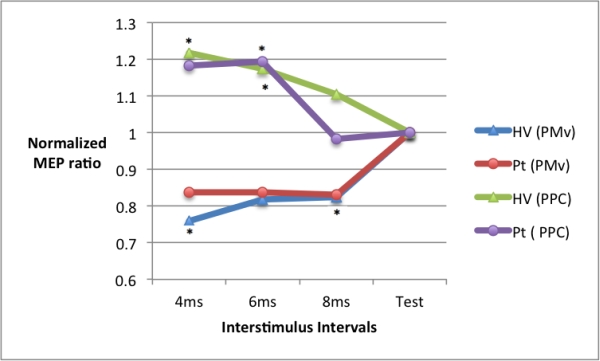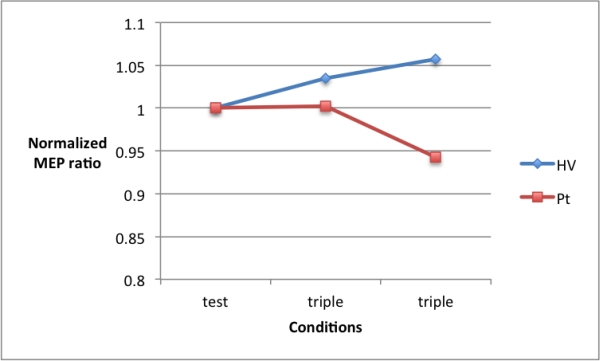Session Information
Date: Thursday, June 23, 2016
Session Title: Dystonia
Session Time: 12:00pm-1:30pm
Location: Exhibit Hall located in Hall B, Level 2
Objective: We aimed to study the influence of the parieto-premotor network on the motor cortex in patients with writer’s cramp.
Background: The parietal and premotor cortices have been shown to be involved in right-handed writing. It has also been shown that the connectivity between these regions may be reduced in writer’s cramp, a type of task-specific focal hand dystonia.
Methods: We used a three single-pulse TMS paradigm (preconditioning, conditioning and test pulse) to sequentially stimulate the left posterior parietal cortex (PPC), left ventral premotor cortex (PMv) and the left motor cortex (M1). A paired-pulse TMS paradigm was used to probe the functional connectivity of the PMv and M1, as well as the PPC and M1 prior to the three single-pulse TMS paradigm.
Results: 8 right-handed healthy volunteers (mean age 55 years, standard error 4 years) and 8 right-handed patients with writer’s cramp (mean age 62 years, standard error 2 years) completed the study. We confirmed the presence of premotor-to-motor inhibition in the healthy volunteer group at interstimulus intervals (ISI)s of 4 ms and 8 ms, while this was not seen in the patient group. Facilitatory influences from the posterior parietal cortex was seen in both groups (ISIs of 4 ms and 6 ms in the healthy group, and 6 ms in the patient group).  The premotor-to-motor inhibition was found to reverse in healthy volunteers (shown in figure 2, as no statistical significance was seen amongst the test and triple conditions), while no effects were seen in patients.
The premotor-to-motor inhibition was found to reverse in healthy volunteers (shown in figure 2, as no statistical significance was seen amongst the test and triple conditions), while no effects were seen in patients. 
Conclusions: We confirmed that in healthy volunteers, the PPC appears to have an influence on the PMv, resulting in reversal of the inhibition seen with PMv paired-pulse stimuli. This along with premotor-to-motor inhibition, was not seen in patients with writer’s cramp. Facilitatory parietal influences on M1, on the other hand, appear to be intact in these patients. These results suggest that the connectivity between PPC and M1 is intact in patients with writer’s cramp, while the connectivity between PPC and PMv, and PMv and M1 appears altered.
To cite this abstract in AMA style:
J.E. Park, P. Mathew, M. Villegas, P. Srivanitchapoom, M. Hallett. Investigation of the influence of the parieto-premotor network on the motor cortex in writer’s cramp using transcranial magnetic stimulation [abstract]. Mov Disord. 2016; 31 (suppl 2). https://www.mdsabstracts.org/abstract/investigation-of-the-influence-of-the-parieto-premotor-network-on-the-motor-cortex-in-writers-cramp-using-transcranial-magnetic-stimulation/. Accessed April 26, 2025.« Back to 2016 International Congress
MDS Abstracts - https://www.mdsabstracts.org/abstract/investigation-of-the-influence-of-the-parieto-premotor-network-on-the-motor-cortex-in-writers-cramp-using-transcranial-magnetic-stimulation/
